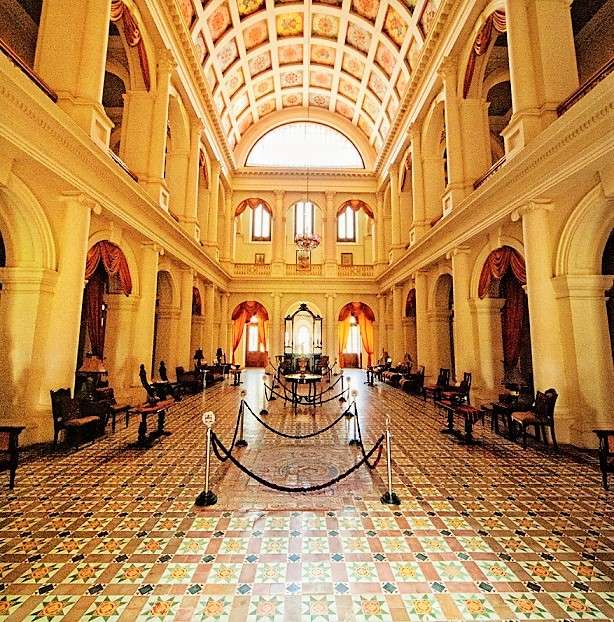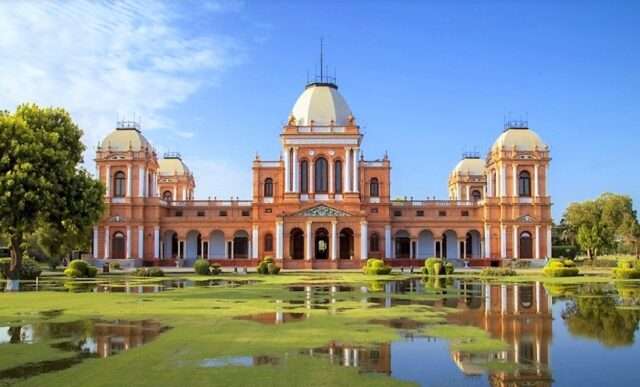Noor Mahal – A Majestic Heritage and monument situated in Bahawalpur, Punjab, Pakistan and is the plac today we shall visit and read about.
There is a palace called The Noor Mahal that is owned by the Pakistan Army. It is located in Bahawalpur, the city of Punjab.
This palace, which is in Bahawalpur, is incredibly gorgeous, with high, vibrant, and beautifully designed ceilings with substantial chandeliers, attractively marbled, tiled floors, and roomy hallways.
Any history-loving traveler will be drawn to it by its spectacular architecture. The interior of the Palace is as gorgeous as it is outside.
The utilization of five domes constructed in the traditional manner is the Noor Palace Bahawalpur’s distinctive architectural characteristic.
1. History of Noor Mahal
Under the supervision of British Engineer Mr. Hennan it was designed. It was constructed in 1872 during the British Raj. It belonged to the Nawabs of Bahawalpur Princely State.
The palace was built by Nawab Sir Muhammad Sadiq, the fifth ruler of Bahawalpur State and known as the “Shahjehan of Bahawalpur” for his love of creating magnificent structures. It was built at a cost of Rupees 1.2 Million.

The palace is filled with many antiques. It has a collection of Nawabs-related artifacts, including legal documents, money, swords, furniture, and a piano. It also has a long wall with pictures of Nawabs on it.
All except one of the images are made entirely in the mind. Alongside the Noor Mahal palace, there is a prison cell as well.
In 1906, Nawab Muhammad Bahawal Khan added a mosque to the palace at the cost of Rs. 20,000.
After the integration of Bahawalpur State into Pakistan, the building was taken over by the Auqaf department in 1956, in 1971; the army purchased the Noor Mahal. The army bought it for 119 million dollars in 9971.
In September 2001, the structure was designated a “protected monument” by the Department of History and archaeology of the Pakistani government. Now, it is accessible to the general public, school field trips, and other interested parties.
The Nawab occasionally conducted cabinet sessions in Noor Mahal while he was in power.
2. Noor Mahal Facts
One of the most recent sites in Punjab to be protected by the Antiquities Act is Noor Mahal. It was constructed for Nawab Sir Muhammad Sadiq’s house.
He did not, however, reside in the palace since the royals preferred not to live close to graves. Noor Mahal – A Majestic Heritage.
Later, the palace served as the official guest home. The Nawab occasionally conducted cabinet sessions in Noor Mahal while he was in power.
The palace served as the State Court on a few occasions when the Nawab addressed his courtiers and the soldiers during battles.
3. Structure and Architecture
The Noor Mahal was constructed in the center of a huge garden with fountains and a water tank. There is 32 rooms total, including a basement. When the building was finished, western artists painted in the palace and added thick carpets to it.
Claims have been made about the Noor Mahal, which is said to have been built entirely of mud formed by combining grains and lentils, rather than iron or cement.

A photograph of Quaid-e-Azam Muhammad Ali Jinnah Portrayed as Poole is also part of the collection. He gave the Nawab that exact table with the pool paddles as a gift.
The majority of the furnishings and building materials came from imports in Italy and Britain. Additionally, mirrors from Belgium and a baby piano from Germany were imported.
High-rise curtains, superb ornaments, elegant rugs, and other fittings give the decor an indigenous flavor. Noor Mahal – A Majestic Heritage.
Additionally, two notable and classic cars are parked on the lawns. One of these is the Shahi Buggy, which the family of Nawab Sadiq utilized for transportation.
According to rumors, Nawab Sadiq Khan constructed the mansion as a gift for his wife Noor. She did, however, only spend one night in Noor Mahal. She relocated to Darbar Palace because the following morning when she awoke, she could view Basti Malook Shah, a local graveyard, from the balcony of her bedroom.
4. Noor Mahal Park
The optimum time to visit Noor Mahal would be before sunset as you will probably spend about two hours there and then continue to watch the exterior’s floodlighting gleaming in the dark. While it appears beautiful in the daytime, it is equally awesome and a treat for the eyes when lit up at night.
In front of Noor Mahal, there is a well-kept grass where visitors can relax with their families.
With the opening of Noor Mahal Park, the overall appearance of Noor Mahal was considerably enhanced in 2017. The park has an auditorium, a jogging track, a children’s play area, a water feature with a bridge, a fountain with an ancient design.
Until his death in London in 1966, the Nawab kept his title, followed the traditional ritual, and earned an annual allowance. His remains were transported to Bahawalpur, where they were laid to rest at his family graveyard at Fort Drawer.
Bahawalpur is also famous for many other architectural wonders and annual Cholistan jeep rally.
His son and the generations were followed and carried on the Nawab title but without the associated political and administrative authority.
Bahawalpur is home to the same tombs, palaces, and ancient structures. Because of its glory, Noor Mahal should not be missed.
Noor Mahal is famous a palace and it is distinguished by its ornate, colorful facade composed of cut and dressed bricks, which makes it a distinctive example of historical construction.
The utilization of five traditional-style domes is the Noor Mahal’s defining architectural element. It is a nice place to Visit. The night view is stunning. Noor Mahal – A Majestic Heritage is one of the famous palaces of Bahawalpur.
The magnificence of Noor Mahal, often known as the “Palace of Lights,” has elevated it to the status of one of Bahawalpur’s most popular tourist destinations.
This magnificent Italian-style palace, which is currently under the management of the Pakistan Army, is accessible to the public every day of the week from 9:00 am to 10:00 pm.
It has been the primary factor of visitors in Bahawalpur’s popularity. It has a significant draw for royal guests in addition to regular visitors. Numerous famous people have visited it and left it with heartfelt tributes.







